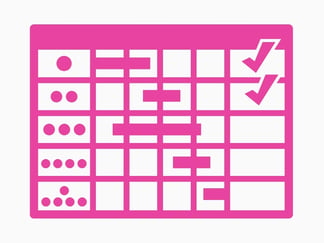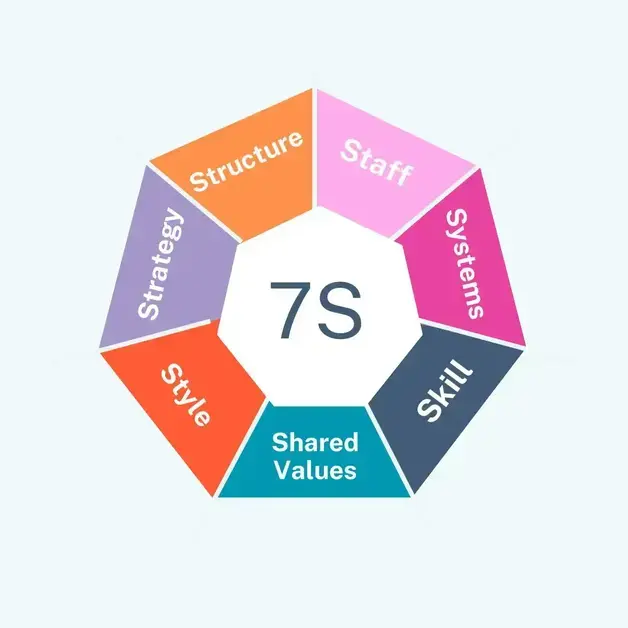McKinsey's 7s Model for Implementing Full Cycle Sales
Why implement a full-cycle sales model? Implementing a full-cycle sales model can provide businesses with a powerful tool to drive revenue growth and...

Gartner Group reports that over 70% of IT projects fail to meet expectations, and that is mostly due to poor Project Management.
The Project Management Institute reports that “only 58% of organisations fully understand the value of project management … (and) … only 23% of organisations use standardised project management practices across the entire organisation.
If you are ever faced with a Gantt chart or a task list referred to as a CRM project plan, then there is an extremely high likelihood of failure. While the schedule is essential, it is only one of seven critical elements of a robust CRM Project Plan.
At the outset, the goal of the project must be crystal-clear to everyone on board. Setting up tangible project goals and objectives is necessary to get all team members on the same page. Knowing exactly what you need to do and having a clear vision of the deliverables, will inform budgeting, resource management, and more intricate details throughout the project lifecycle. This will also help you begin to figure out which tasks or phases of the project are most critical and need to be prioritised.
Effective communication is key for all project managers and small business owners. Maintaining clear and consistent communication with project stakeholders, team members, vendors, and clients is crucial to keeping everyone informed about the project's progress. This not only helps to identify any issues early on in the project lifecycle but also prevents them from escalating into larger problems in the future.
To streamline communication, consider using collaboration tools like Slack to organise and manage your communications efficiently. By keeping everyone on the same page, you can ensure smoother project execution and successful outcomes.
Managing major projects involves balancing budgets, engaging stakeholders, meeting deadlines, and navigating various challenges. A centralised project plan serves as your roadmap, offering updates on progress and capturing key insights post-completion.
 tion Charter
tion CharterAn executive summary of what is to be achieved. It will also include a detailed timeline, outcomes and a description of who is involved in the project.
The Project Management Execution Project Charter is a short, preliminary document that provides authority for the Project Work to begin and establishes the authority of the Project Manager. A Project Charter document describes a project to create a shared understanding of its goals, objectives and resource requirements before the project is scoped out in detail.
Project Stakeholders are “Individuals and organisations who are actively involved in the project, or whose interests may be positively or negatively affected as a result of project execution or successful project completion" as defined by the Project Management Institute.
 Not all Stakeholders are equal, so it's important to do a Stakeholder Analysis so you can prioritise your Stakeholders. There are two primary types of project stakeholders - internal and external stakeholders;
Not all Stakeholders are equal, so it's important to do a Stakeholder Analysis so you can prioritise your Stakeholders. There are two primary types of project stakeholders - internal and external stakeholders;
Internal stakeholders: These stakeholders originate from within the organisation. Internal stakeholders encompass individuals or groups within the company, including team members, managers, executives, and other relevant parties.
External stakeholders: These stakeholders are individuals or groups external to the organisation. This encompasses customers, users, suppliers, and investors who may have a vested interest in or be impacted by the project's execution or successful completion.
The types of stakeholders in project management you will see are;
Project manager and team
Functional Line Managers
Resource managers
Executives/Senior management
Company owners
Investors
Stakeholders may change throughout the project, so it's essential to have the contact details of executives, managers, users, and influencers involved in or affected by the project to keep them updated on the status of the project items that matter most to them. Various factors play a significant role in shaping stakeholder communication.
Including Requirements Definition and Specification and Exclusions
Requirements definitions detail both WHAT the project will enable and exactly HOW the functionality, system and support will deliver the WHAT. They provide a clear framework for all stakeholders to strive towards, even when not all stakeholders have a precise vision of the finer details. The definition should also include Testing Requirements and scripts to prove the requirements have been met in accordance with the agreed business process.
In such instances, delving deep into project requirements becomes crucial to unveiling all layers and gathering comprehensive information before kicking off the project.
Project spec is a comprehensive document outlining the objectives, functionality, and ultimate purpose of a business plan implementation. It includes details on the software to be utilised, performance expectations from a user perspective, all within a concise format of just a few pages.
This document serves as a vital tool to guide developers on precisely what needs to be accomplished. Collaboration is key in its development, involving input from managers to developers across the board.
Project Specifications are essential for any project, especially a tech project, whether it be a website, or a business application. They provide a detailed roadmap for project development, outlining all necessary components for successful project completion.
When managing scope, it's crucial to define not only what you will do but also what you won't. Setting clear boundaries is key in staying focused on the project at hand.
click here to get your complimentary buyers guide
A detailed explanation of how the project will be delivered, including methodology, standards and Quality Assurance processes.
Your delivery approach may be customer-led, or maybe its focus is to minimise risk. Once you have established your approach, you need to communicate the methodology to be used in the project. There are many types of project delivery methods for professional services, including:
The Project Management Institute has a comprehensive blog article to help best decide on the Project Delivery Approach
 Detailed task lists with associated timeframes and resources
Detailed task lists with associated timeframes and resources
When mapping out your tasks, it is crucial to establish realistic timelines. While this may be simpler with smaller, seasoned teams, it can pose a greater challenge with larger, newer teams. Setting achievable timelines helps prevent overcommitting to clients and underestimating the time and effort needed to deliver all project components.
Moreover, this approach enables better expectation management and more effective communication with stakeholders. It is always wiser to err on the side of caution by overestimating and under-committing rather than risking client dissatisfaction, which could deter future collaborations. Maintain transparent and efficient communication with your team and stakeholders to ensure everyone is on the same page regarding timelines and to prevent any client disappointment.
Including fully documented risks, assumptions and dependencies
While there is some overlap between RAID Log and Risk Register documents, the difference is that a RAID log is more comprehensive than a risk register. In addition to documenting risks, a RAID log also includes assumptions or actions, an issues log, and dependencies or decisions.
Log of all tasks and assigned responsibilities
The project log serves as a centralised repository for the project team, allowing them to monitor any changes made throughout the project lifecycle. It acts as a valuable tool for documenting past project details, capturing any revisions made in your absence, or any crucial information that may have been overlooked.
This comprehensive document meticulously tracks all project events, not only logging critical decisions but also offering insights into the individuals involved and the reasoning behind those decisions.
Got questions?
When analysing proposals for CRM implementation and adoption, here is a proven rule of thumb:
-25% of a project cost is project management and related activities
-25% to system and user acceptance test and associated documentation,
-25% to requirements definition documentation, sign off and design,
-25% to implementation
Neglecting to invest enough in project management, such as solely relying on a task list, can steer the project towards becoming part of the alarming 70% of projects that fail.
Get in touch with our team if you'd like to chat about our Project Management approach.

Why implement a full-cycle sales model? Implementing a full-cycle sales model can provide businesses with a powerful tool to drive revenue growth and...

HubSpot Partner located in Dublin and Belfast specialising in large complex Enterprise Sales through to Customer Service Operations Management...

Learn how to effectively implement spin selling strategies to boost sales and drive business growth